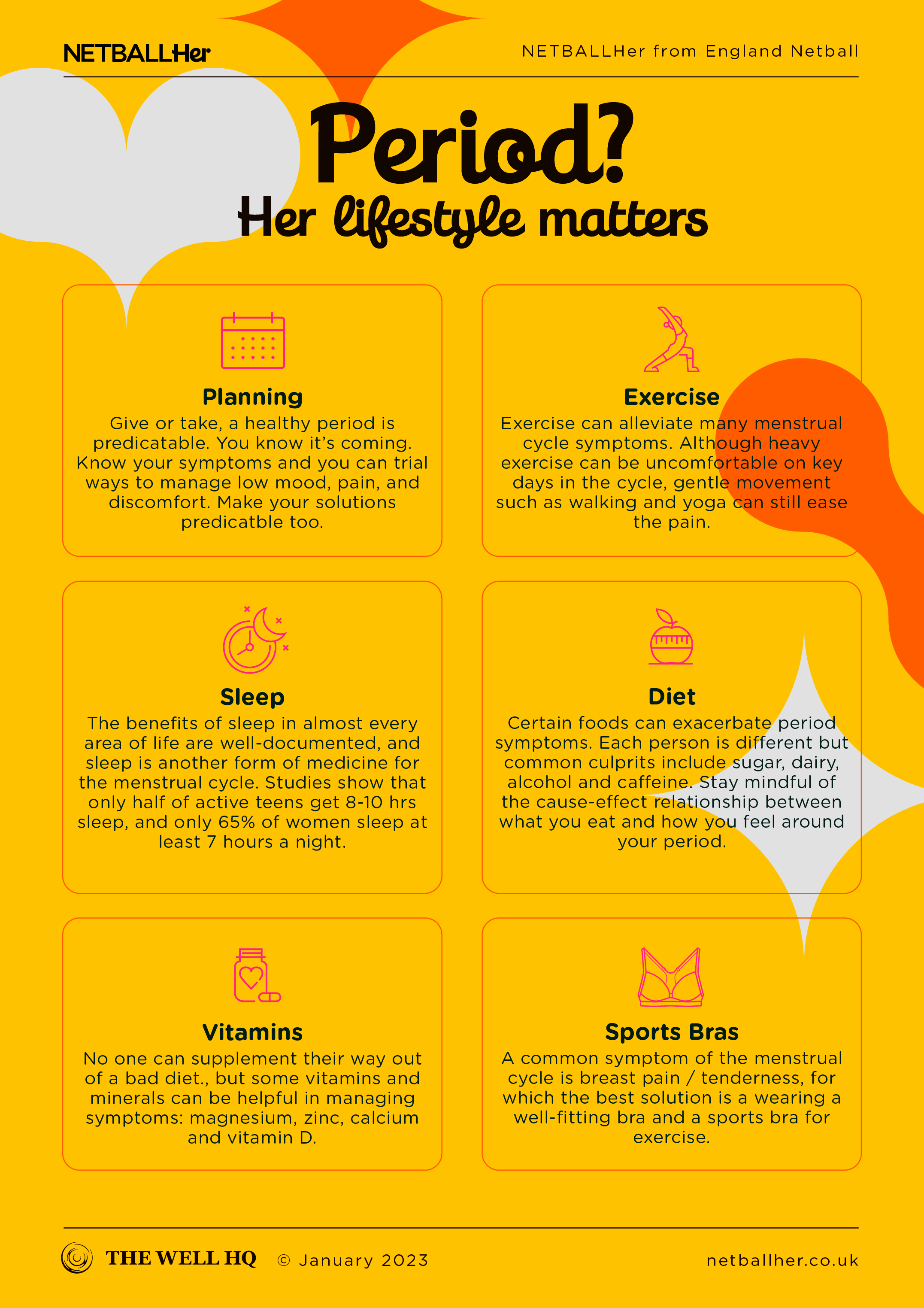Click play for an audio readthrough of this article
Our whole lives we’re taught about the menstrual cycle from a medical point of view – eggs, and fallopian tubes. Very few of us are taught about its impact on how we feel, physically and emotionally, or its influence on our netball training and performance, or how to manage the many varying symptoms that can put us out of action.
Some 90% of women say they haven’t had enough education about their cycle and how it relates to exercise. In sport we’ve become somewhat accomplished at tuning into other hormones and taking advantage of them in our warm-ups, training adaptation, nutrition and recovery, but we’ve failed to really tune in, understand and capitalise on menstrual cycle hormones in the same way.
When it comes to the menstrual cycle and exercise, there is no right or wrong way to train at any time of your cycle. In fact, exercise is a good idea on any day of your cycle; it’s often a brilliant way to manage symptoms because it releases feel-good endorphins which are nature’s painkillers and mood elevators. So even if you have period pain, or feel extra tired or a bit low, you may be surprised by how much better you are after even light exercise.
Studies show that regular exercise greatly reduces how bad premenstrual symptoms can feel. Conversely, we also know that avoiding exercise is linked to more and worse symptoms in the days before your period.
Here’s more on how to manage your menstrual cycle symptoms.
What’s more, research has shown that determinants of netball performance, such as V̇O2 max, (that’s aerobic fitness), speed and power are not affected by the changing physiology of the menstrual cycle. Basically, you’re not any stronger or faster at different times of the cycle but it’s the symptoms you experience which may impact your ability to be fast or strong on that day. No-one is going to PB their 20-metre sprint time if they’re suffering bad period pain, or they’ve been on the loo all morning with diarrhoea, or they have a migraine.
Making sure you can show up and be your best netball self on any day of your cycle is down to understanding your experience of the cycle, leaning into the good bits, and proactively doing something about the bad bits.
Understand your experience of the cycle
Hormones fluctuate across our menstrual cycle, and although we know that most healthy women will experience the same pattern of hormonal peaks and troughs <link to cycle infographic> every woman responds differently to these hormones. Each body releases different levels of hormones and each body processes these hormones differently. It’s kind of like alcohol: some drink one glass and end up on the floor, others seem fine after several.
So whilst your teammates might be experiencing heavy periods and premenstrual headaches, your own experience might feel very different. That’s totally normal. But it’s also the reason it’s so important that you really get to know your experience of the menstrual cycle: how you feel physically and emotionally, in training, at work, or in relationships, as the hormones of your cycle rise and fall. That’s why tracking your cycle is such an important tool for netballers to have in their locker.
What the cycle holds for an active body
We can think of the cycle as four different ‘hormonal states’. During your period both the hormones of the cycle (oestrogen and progesterone) are low. After your period oestrogen rises to its peak just before the halfway point of your cycle. In the third week of your cycle, both progesterone and oestrogen are elevated, and then the levels of both of these hormones drop rapidly in the final week of your cycle, before your next period arrives.
The first half of your cycle (the follicular phase)
As you track your cycle, you might find that after your period has finished you start to feel pretty good. That’s because oestrogen is our ‘go get-em’ hormone! Oestrogen can increase the levels of the mood-enhancing neurotransmitter serotonin which can improve mood, motivation to train and energy levels.
When it comes to our training, oestrogen creates what we might call an ‘anabolic’ environment – where muscle repair and growth is supported. Research has shown recovery is quicker with less muscle soreness experienced after heavy workouts at this time of the cycle. Oestrogen also helps your body make glucose more readily available to your muscles to use for fuel. This helps improve energy levels during high intensity workouts; where glucose is the body’s main fuel of choice. So high intensity exercise might feel really good at this time in your cycle.
Because of the helpful effects of oestrogen at this time of the cycle, researchers have explored whether more resistance training in this first half of the cycle increases strength gains compared to regularly spaced strength training throughout the whole cycle.
These researchers ‘compressed’ strength training sessions into the first two weeks of the cycle, performing it on every other day, and then limited strength training to just two sessions in the second half of the cycle. Compared to regularly performing the same amount of strength training spaced evenly across the cycle, the research showed women who stacked strength training in their follicular phase (we call this SSTiF training) had up to 20% greater improvements in strength gains.
Now, training in this way isn’t always pragmatic when training as a netball team. You can’t allow every player to do something different in training based on where she is in her cycle – that’d be chaos! So taking advantage of the positive influence of oestrogen on muscle adaptation might just be knowing that, if you’re in this phase of your cycle, you can really go for it in a sprint interval session, or you can choose to do a strength set at the gym knowing that, when it comes to recovery and adaptation, your body’s on your side.
Among all its superpowers, oestrogen does have its pitfalls. Oestrogen affects the laxity (the stretchiness) of the ligaments that hold joints in place so if you land from a jump, or plant a foot to suddenly change direction, the joint might be slightly less stable and this becomes a risk factor for injury.
But this isn’t a reason to back off training or to feel anxious about getting injured. If you find that you feel less stable, or you have muscle tightness around the hips and legs which flares up at certain time of the cycle, then you’re in a much better position to do something about it like taping and strapping, or doing more dynamic stretching before getting on court and getting in a longer warm up before playing.
England Netball have also created a brilliant injury resilience programme, which is designed to make players develop strength and great movement technique to reduce injury risk, especially at the knee joint. Creating strong, stable and resilient joints means that you can offset any impact that cycle hormones might have on this aspect of your body.
The second half of your cycle (the luteal phase)
As your cycle progresses and progesterone rises, around the third week of your cycle, it can have a calming influence on the nervous system, promoting quicker onset of sleep and better quality of sleep. These conditions are great for recovering from those strenuous workouts. Progesterone’s influence on the brain has also been shown to make us more tolerant of pain during this part of our cycle.
The flip side is that progesterone’s effects on the brain in the second half of your cycle could potentially affect skill and coordination. So during this time you may feel slightly clumsy. You may feel less able to coordinate your movements in time and space, or to quickly pick up new skills or moves.
Again, you don’t have to just put up with this, certainly not if it affects your netball, so you can look to caffeine to influence your alertness and cognition. Also, aerobic exercise can enhance the signalling in your brain, and / or you can add a session into your warm-up that fires up your neuromuscular system.
Activities that involve strong muscle contractions, skill or agility can be particularly useful if you know your cycle affects your coordination. If you’ve a big tournament or event that falls at this time then you could start to plan competition day with some purpose: building caffeine into your pre-event snack and modifying your warm-up to include more aerobic work and drills that fire up your nervous system.
Progesterone raises your body temperature by about half a degree in the second half of your cycle. This doesn’t sound like a lot, but our body does an amazing job of keeping our internal temperature within a very tight range so it’s actually quite a significant rise. You may feel yourself getting hotter during exercise, or you might find exercising in hot weather more uncomfortable at this time of your cycle.
Raised levels of oestrogen and progesterone in the second half of the cycle also influence how our body likes to make energy for exercise. At this time it’s been shown that the body prefers to use fat as fuel. This slow-burn, energy-rich fuel is great for sustaining steady exercise for longer periods of time so certain types of training might feel particularly good, or less energy-zapping at this time of your cycle.
Progesterone also has a tendency to slow down your digestion, which can leave you feeling bloated or constipated. This too can impact your energy levels and/ or how fun it feels to move your body on court.
The premenstrual phase
Towards the end of your cycle is often the crap bit. As we close in on our period our hormone levels drop and any number of the 150 reported symptoms might kick in. Roughly 90% of women suffer premenstrual symptoms which can impact exercise, performance and how much we enjoy it.
It’s not oestrogen and progesterone activity that causes period pains, cramps and symptoms. In reality, the tapering off of these two key hormones actually causes a bit of a withdrawal or a ‘hormone hangover’.
The key to being able to perform at your best during this time is often down to how well you can manage your symptoms, emotions and energy levels. Some of this is down to the individual but you don’t have to do it alone.
It can be really helpful to chat with your coach and teammates about what you are experiencing and what might help. If your coach knows that you’re emotionally fragile in the days before your period they might take a more sensitive approach to getting the best out of you … or they might simply understand better why some days you’re quieter than others.
Understanding how your cycle shows up and impacts you physically and emotionally, for better or worse, is all about providing you with context. On offer is important information about why one training session feels great but the same one two weeks later feels awful and leaves you sore and tired. On offer is appreciating why some days you don’t feel as tuned in to team dynamics, or as motivated to get out and train.
At the very least, understanding your cycle can reduce anxiety and anguish. At best, understanding your cycle means you can take control and make choices about the bits you want to change … and the bits you can capitalise on.
As a reminder, the content of the course belongs to The Well HQ. You have permission to access and use the content yourself or, if you are an organisation, for the number of users selected, but are not otherwise permitted to share such content with others, all in accordance with our Course Terms and Conditions.

